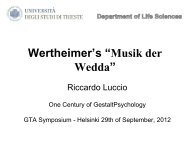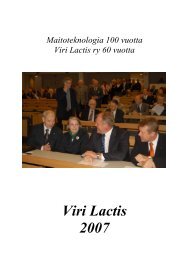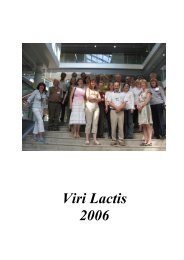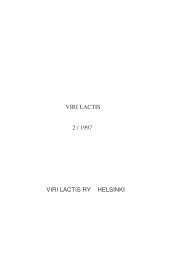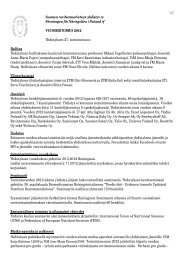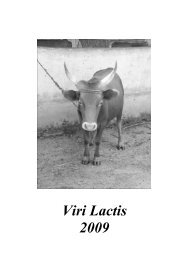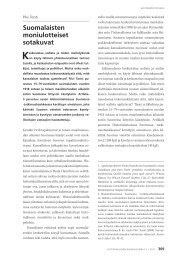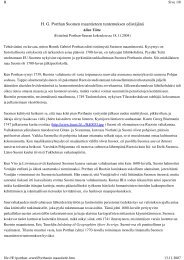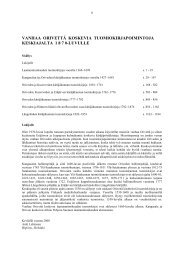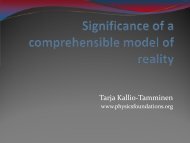Gestalt Psychology in Context
Gestalt Psychology in Context
Gestalt Psychology in Context
Create successful ePaper yourself
Turn your PDF publications into a flip-book with our unique Google optimized e-Paper software.
E<strong>in</strong>o Kaila <strong>in</strong> the <strong>Context</strong> of <strong>Gestalt</strong> <strong>Psychology</strong> <strong>in</strong> the German-Language<br />
Cultural Area <strong>in</strong> Europe
E<strong>in</strong>o Kaila: Some Biographical Data<br />
• *b. 1890, d. 1958<br />
• *In his time, lead<strong>in</strong>g<br />
philosopherpsychologist<br />
<strong>in</strong> F<strong>in</strong>land<br />
• *Founder of modern<br />
psychology <strong>in</strong> F.<br />
• *<strong>Gestalt</strong>-orientation,<br />
dynamic psychology,<br />
empirist, experimental<br />
psychologist
Unity of Human Personality<br />
• ”Faust, as the prototype of man, found that striv<strong>in</strong>g for<br />
completeness was not merely an abstract matter. The only<br />
practicable condition of unity that he discovered was the<br />
seek<strong>in</strong>g of specific objectives related to a life work.” Gordon<br />
W. Allport: Personality, a Psychological Interpretation,<br />
1937, p. 351. Allport is here discuss<strong>in</strong>g the unity of<br />
personality and uses Goethe’s Faust as example.<br />
• ”It is erroneous to place verstehende psychology as an<br />
<strong>in</strong>dependent discipl<strong>in</strong>e <strong>in</strong> opposition to psychology as a<br />
natural science. There is only one unitary psychology …”<br />
William Stern, Weltphilosophie, 1924. Citation from<br />
Allport, 1937, p. 542
The Litterary Production of E<strong>in</strong>o<br />
Kaila<br />
1. Philosophical writ<strong>in</strong>gs<br />
1.a. Academic philosophy<br />
1.b. Writ<strong>in</strong>gs on world-views and values<br />
2. Psychological writ<strong>in</strong>gs<br />
• 2.a. Scientific-professional studies<br />
• 2.b. Works of a popular & general nature<br />
3. Political writ<strong>in</strong>gs and essays<br />
4. Writ<strong>in</strong>gs on litterature & criticism<br />
5. Speeches & talks<br />
6. Translations, prefaces, and other essays
The Ma<strong>in</strong> Purposes of this<br />
Presentation<br />
1. To study the personality-psychology of EK from a <strong>Gestalt</strong>-theoretical<br />
po<strong>in</strong>t of view.<br />
2. To study the text of the textbook on personality psychology by EK.<br />
3. To study the context of EK’s personality psychology with the help of<br />
references used by EK <strong>in</strong> his book.<br />
4. To assess critically the results of this analysis, and to cont<strong>in</strong>ue the<br />
discussion of the personality psychology of EK with the help of other<br />
means, if needed.<br />
5. To def<strong>in</strong>e the position of EK with respect to the various psychological<br />
traditions prevalent <strong>in</strong> early 20th century (the context).
The Structure of this Presentation<br />
1. Introduction<br />
•2. A new dat<strong>in</strong>g of the <strong>Gestalt</strong>-change <strong>in</strong> the th<strong>in</strong>k<strong>in</strong>g of EK.<br />
•3. The textbook ”Personality” (1934)<br />
•4. The contents of this book<br />
•5. Discussion of references used by EK <strong>in</strong> this book.<br />
•6. Some critical comments<br />
•7. Some conceptual remarks<br />
•8. Conclusions and discussion
Do We Understand Historical Texts<br />
<strong>in</strong> <strong>Psychology</strong>?<br />
1. 1. Concepts and contexts are different<br />
2. 2. Concepts refer to different ideas & th<strong>in</strong>gs<br />
3. 3. The experimental & empirical context is forgotten<br />
4. 4. Different techniques are used <strong>in</strong> the written textss<br />
5. 5. Bibliographies & references are different<br />
6. 6. In some cases, references & notes are simply lack<strong>in</strong>g<br />
7. 7. The writers presume that readers know certa<strong>in</strong> references because<br />
they are ”self-evident”<br />
E.g. Concepts like apperception, avidity, structuralism, vector, valence etc.
When Kaila Became a <strong>Gestalt</strong> -<br />
Theorist?<br />
- In 1920, <strong>in</strong> a paper ”Philosophical Remarks on the Theoy of Relativity”;<br />
Kaile refers to Wolfgang Köhler and his experiments with anthropoids.<br />
- In the same paper, he refers to the active function of the perception.<br />
- In a paper on ”The Psychological Foundations of the Physical World-<br />
View” (1922), he uses a figure which may be <strong>in</strong>terpreted <strong>in</strong> three<br />
different ways. This figure can found <strong>in</strong> Koffka 1934. He has taken it<br />
from Bühler 1913.<br />
- New dat<strong>in</strong>g of the change: 1920, or early 1920’s. My earlier def<strong>in</strong>ition:<br />
1928 – 1932. This must now be changed.
Sail, flag, or parallelogram?<br />
Kaila 1922 Koffka 1934 (after Bühler 1913)
About the Book<br />
• *First ed. 1934<br />
• *Fourth ed. 1952<br />
• *The book-cover is from<br />
sixth pr<strong>in</strong>t<strong>in</strong>g <strong>in</strong> 1964<br />
(Everyman’s University-<br />
Series)<br />
• *First Swedish edition <strong>in</strong><br />
1935. Danish edition <strong>in</strong><br />
1948. Further editions<br />
and impr<strong>in</strong>ts were to<br />
come.
Chapter-Head<strong>in</strong>gs <strong>in</strong> ”Personality”<br />
I. Lead<strong>in</strong>g Ideas: Verstehen Ganzheit, <strong>Gestalt</strong>en, dynamics of p.,<br />
biological basis, holism aga<strong>in</strong>st mechanistic conceptions.<br />
II.<br />
III.<br />
IV.<br />
The Mean<strong>in</strong>gful Life of the CNS<br />
Biology of the Character.<br />
Dawn of Higher Psychological Functions<br />
V. Dynamic Forces of the M<strong>in</strong>d<br />
VI.<br />
Social Ties and Bounds<br />
VII. Dynamics of Needs and Drives<br />
VIII. Human Personality as a Whole<br />
IX.<br />
Animal and Deep-Spiritual Life
My Ma<strong>in</strong> Sources <strong>in</strong> <strong>Gestalt</strong> Theory<br />
• Max Wertheimer, Productive Th<strong>in</strong>k<strong>in</strong>g 1966; some articles;<br />
K<strong>in</strong>g&Michael Wertheimer(2007)<br />
• Kurt Koffka, Pr<strong>in</strong>ciples of <strong>Gestalt</strong> <strong>Psychology</strong> (1934);Growth of the<br />
M<strong>in</strong>d (1924)<br />
• Wolfgang Köhler, <strong>Gestalt</strong> <strong>Psychology</strong> (1947); The Mentality of Apes<br />
(1973); Selected Papers; Values … (1966/1938)<br />
• Kurt Lew<strong>in</strong>, A Dynamic Theory of Personality (1935); Field Theory <strong>in</strong><br />
Social Science (1951); Vorsatz, Wille und Bedürfnis (1926)<br />
• Kurt Goldste<strong>in</strong> (1995); Mitchell G. Ash (1998); Wolfgang Metzger<br />
(1954); Karl Duncker (1968);Mary Henle and W.D. Ellis ;David Katz,<br />
<strong>Gestalt</strong> <strong>Psychology</strong>
<strong>Gestalt</strong> Arguments <strong>in</strong> ”Personality”<br />
• Some examples:<br />
1. The Idea of holism, Ganzheit, <strong>Gestalt</strong><br />
2. The idea of psychological & social field<br />
3. Biological roots emphasized, <strong>in</strong>terest <strong>in</strong> CNS and animal study<br />
4. Critique of Constancy Hypothesis (cf. Köhler, Koffka)<br />
5. Lew<strong>in</strong>ian ideas <strong>in</strong> personality dynamics<br />
6. Integration of lower-level and higher-level functions<br />
7. Structure and function<br />
8. <strong>Psychology</strong> is analytic science, top down
One Page from the Bibliography
One Page-Open<strong>in</strong>g from the<br />
Bibliography
Details of One Page <strong>in</strong> Bibliography
Some Methodological Problems<br />
1. The bibliographic data are scanty<br />
2. Difficulties <strong>in</strong> trac<strong>in</strong>g a relevant edition<br />
3. Sometimes only the name of author is given, possibly the name of the<br />
editor, but noth<strong>in</strong>g more<br />
4. There may be more than one document from one author<br />
5. There may be a number of various authors <strong>in</strong> one reference<br />
6. In some cases the translation of relevant concepts is difficult to <strong>in</strong>terpret,<br />
(e.g. the concept of temperament which <strong>in</strong>cludes impressivity,<br />
psychological tempo (tahti), and expressivity)<br />
7. Example: <strong>in</strong> Chapter II, reference 16: ”See the writ<strong>in</strong>gs by Bethe, von<br />
Weitzsäcker, Goldste<strong>in</strong> <strong>in</strong> the Handbook edited by Bethe, vol. X.In<br />
addition, Goldste<strong>in</strong>’s writ<strong>in</strong>gs <strong>in</strong> Archiv für Psychiatrie, Band 74, 76.<br />
Lashley, Nervous Mechanisms <strong>in</strong> Learn<strong>in</strong>g, Murchison,A. Handbook of<br />
General Experimental <strong>Psychology</strong>, pp. 456-496.”
Some Difficult<br />
Concepts/Ideas/Methods<br />
• - The relationship between constancy phenomenon and constancy<br />
hypothesis:<br />
• - The various ”errors” <strong>in</strong> cognitive processes;<br />
- The concept of avidity;<br />
- Use of ”ressentiment” as a technical term;<br />
- The various levels of personality (animal, deep-spiritual) and their<br />
isomorphic correspondences <strong>in</strong> CNS;<br />
- Fast and flexible navigation between phenomenological, behavioral,<br />
biological, and social concepts <strong>in</strong> the text.
Top Ten References (Names)<br />
1. Kurt Lew<strong>in</strong> (12)<br />
1. 2. Ernst Kretschmer (12)<br />
2. 3. Pierre Janet (12)<br />
3. 4. Max Scheler (11)<br />
4. 5. Arthur Schopenhauer (8)<br />
5. 6. Kurt Goldste<strong>in</strong> (8)<br />
6. 7. David Katz (8)<br />
8. 8. Wolfgang Köhler (7)<br />
9. 9. Sigmund Freud (7)<br />
10. Paul Schilder (6)
Top 13 References <strong>in</strong> the Text<br />
• 1.F.Nietzsche(10)<br />
• 2.S. Freud(9)<br />
• 3.A.Schopenhauer(8)<br />
• 4.Kurt Lew<strong>in</strong>(6)<br />
• 5.Max Scheler(5)<br />
• 6.Aristotle(5)<br />
• 7.E.Kretschmer(5)<br />
• 8.Henry Head (5)<br />
• 9.J.W.von Goethe(4)<br />
• 10.Descartes(4)<br />
• 11.Ivan Pavlov(4)<br />
• 12.G.W.F.Hegel(4)<br />
• 13.William James (4)
Some More References <strong>in</strong> Text<br />
• Three times: Alfred Adler, Plato, Rousseau, Rochefoucault, Schiller<br />
• Two times: Victor von Weitzsäcker, Kurt Goldste<strong>in</strong>, Wolfgang Köhler,<br />
Ta<strong>in</strong>e Edouard Zeller, Bertrand Russell, Schjelderup-Ebbe, August<strong>in</strong>us<br />
• SOME MORE STATISTICS:<br />
• All <strong>in</strong> all, 196 various names <strong>in</strong> the text. In the text-references, there<br />
are 98 various names of authors.<br />
• The total number of references is 334.
Types of Referencess<br />
1. Scientific and professional<br />
•1.a. Biological & b iomedicaal<br />
•1.b. Psychological & sociological<br />
•1.c. Physics<br />
2. Classics (e.g. Greek tragedies)<br />
3. Philosophical<br />
4. Historical (Ta<strong>in</strong>e, Burchard)<br />
5. Biographical (William James)<br />
6. From litterature<br />
7. Other
Number of References Accord<strong>in</strong>g<br />
to Type<br />
• 1.a. N = 63<br />
• 1.b. N = 85<br />
• 1.c. N = 7<br />
2. 2. N = 7<br />
3. 3. N = 55<br />
4. 4. N = 14<br />
5. 5. N = 14<br />
6. 6. N = 8<br />
7. 7. N = 8<br />
•Sum total = 336
Example of a Reference<br />
• In bibliography for Ch. I, Lead<strong>in</strong>g Ideas, reference 21:<br />
• Planck, Forschungen und Fortschritte 5,2<br />
• This refers to: Planck, Max : Aus der neuen Physik. Forschungen und<br />
Fortschritte 1929;5:16-17.<br />
• Possible idea that Kaila noted: ”The physical world is not simply a sum<br />
of spatial and temporal s<strong>in</strong>gle worlds runn<strong>in</strong>g one besides the others,<br />
and many phenomena escape the understand<strong>in</strong>g when one does not<br />
consider a physical object as a whole.” Citation after Drack, Apfalter &<br />
Pouvreau 2010
A Surpris<strong>in</strong>g Addition: the Bible<br />
• Citations:<br />
• Genesis 1<br />
• Matthew 4<br />
• Colossians 1<br />
• 1 Cor<strong>in</strong>thians 9<br />
• 2 Cor<strong>in</strong>thians 1<br />
• Sum total: 16
Some Comments on the Sources<br />
Used by Kaila<br />
• Total number of different names/authors is 191.<br />
• The scale of these names is wide: from Charles Darw<strong>in</strong> to Claude Lévy-<br />
Bruhl, from Bertrand Russell to Max Scheler, from Rene Descartes to<br />
Sigmund Freud and Alfred Adler.<br />
• In the references one f<strong>in</strong>ds many different sources, and <strong>in</strong> the statistics<br />
<strong>Gestalt</strong> theory is not dom<strong>in</strong>at<strong>in</strong>g. However, <strong>in</strong> the argumentation & <strong>in</strong><br />
the theoretical background GT is a dom<strong>in</strong>ant factor. Statistical<br />
approach has its limitations even if it provides some useful<br />
<strong>in</strong>formation.
<strong>Gestalt</strong> Pr<strong>in</strong>ciples <strong>in</strong> ”Personality”<br />
•1. Criticism of the constancy-hypothesis<br />
•2. Adoption of the constancy pr<strong>in</strong>ciple<br />
•3. Adoption of holistic and <strong>Gestalt</strong>-perspective<br />
•4. Critique of the concept of ”unconscious”<br />
•5. Structure and function<br />
•6. Personality dynamics based on needs (and drives)<br />
•7. Person and environment<br />
•8. Experience vs. behavior<br />
•9. Biological roots
A Poet Looks at Human Personality<br />
• Des Herzens Wege schäumte nicht so empor und<br />
würde Geist,<br />
wenn nicht der alte stumme Fels, das Schicksal, ihr<br />
entgegenstünde.” - Hölderl<strong>in</strong>, citation from<br />
”Persoonallisuus” (1964) by E<strong>in</strong>o Kaila, p. 278
Some Contributions of E<strong>in</strong>o Kaila<br />
1. Expanded use of <strong>Gestalt</strong> pr<strong>in</strong>ciples to cover the structure and<br />
dynamics of human personality<br />
2. Integration of <strong>Gestalt</strong> pr<strong>in</strong>ciples with dynamic psychology<br />
3. Generalization of <strong>Gestalt</strong> pr<strong>in</strong>ciples & Lew<strong>in</strong>ian psychology to cover<br />
both human & animal psychology<br />
4. Integration of psychological & biological viewpo<strong>in</strong>ts, <strong>in</strong>clud<strong>in</strong>g<br />
sociological perspectives and cultural studies<br />
5. Integration of research-oriented scientific psychology with<br />
humanistic psychology
What Was Not Discussed <strong>in</strong> This<br />
Presentation?<br />
• E<strong>in</strong>o Kaila and values <strong>in</strong> ”Personality”;<br />
• Some detailed descriptions of religious processes and<br />
beliefs;<br />
• Philosophy of science and methodology <strong>in</strong><br />
”Personality”;<br />
• Heredity, anatomy of CNS and its relationship with the<br />
m<strong>in</strong>d’s structures (isomorphism);<br />
• Neuroses accord<strong>in</strong>g to Kaila;<br />
• Animal psychology and its relationships with human<br />
psychology, evolutionary viewpo<strong>in</strong>ts, etc.



